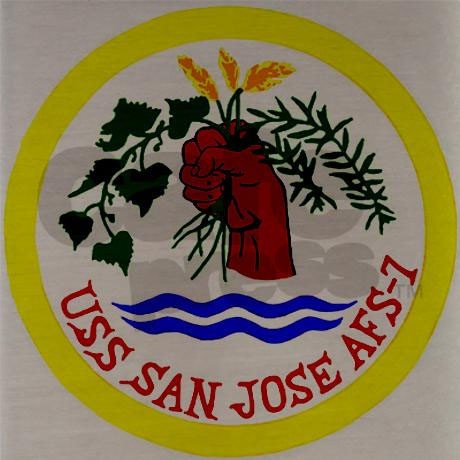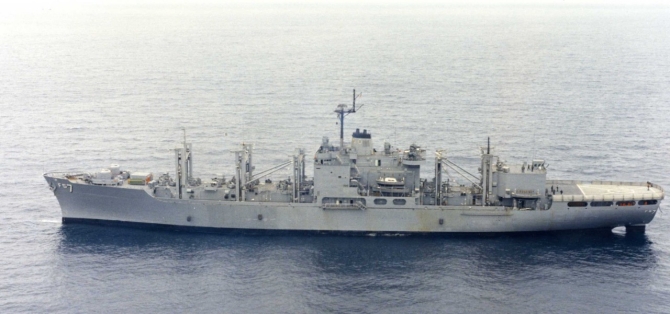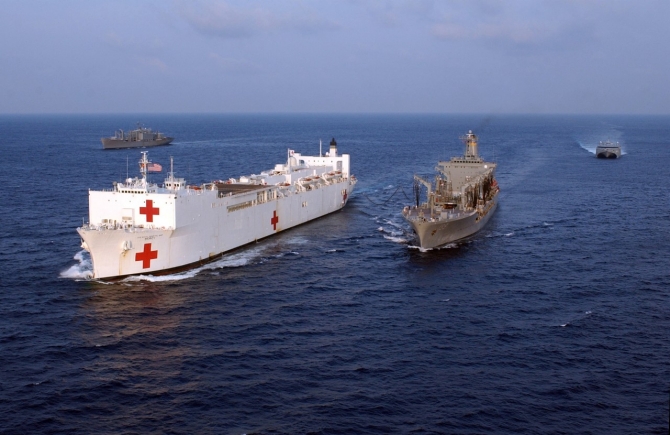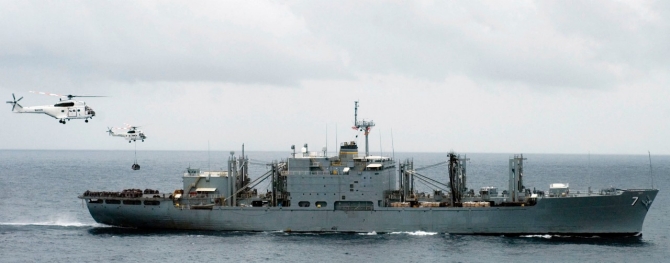San Jose (AFS-7)
1970–2010
A city in California.
(AFS-7: displacement 17,373; length 581'; beam 79'; draft 27'; speed 20+ knots; complement 462; armament 8 3-inch; aircraft 2 Boeing Vertol UH-46 Sea Knights; class Mars)
San Jose (AFS-7) was laid down on 8 March 1969 at San Diego, Calif., by National Steel and Shipbuilding Co.; christened by Mrs. Melissa E. Ellis for the sponsor, her mother, Mrs. Juliette H. Murphy, wife of Senator George L. Murphy of California, and launched on 13 December 1969; and commissioned at Long Beach Naval Shipyard, Calif., on 23 October 1970, Capt. James H. Morris in command.

The origin of San Jose’s insignia lies in early maritime history. The circular shape symbolizes the manner in which seas encompass the earth. The two undulating lines are derived from ancient Greece, and represent the two oceans that border the United States. The grape vine and wheat are taken from the seal of the city of San Jose. They typify the city’s role as a center of agriculture. The wheat also signifies man’s need for nourishment and relates to San Jose’s mission of supplying the fleet with food. The olive branch stands for the Navy’s role as peace keeper of the seas. The upraised forearm and fist have their source in medieval heraldry and mean “Ready For Action.” Collectively, San Jose’s coat of arms express the ship’s dual heritage, from the city and the Navy, and her dual mission, to aid in keeping the peace and to carry stores to naval ships.
Following commissioning and fitting out, San Jose operated as part of the Pacific Fleet Service Force. She made a short cruise from San Diego to Acapulco, Mexico (7–17 December 1970), recovering a small capsized Mexican fishing boat without crew or passengers at 27°10'N, 115°6'2"W, on 8 December. The ship turned over the boat to the Mexican authorities upon her arrival at Acapulco. San Jose’s historian observed that she embarked and loaded a “multitude of families, pets and cars and carried everyone on a maiden voyage” to Oakland, Calif., for the ship’s “first arrival in her homeport area” (8–9 February 1971).

San Jose sailed on her maiden deployment (11 September 1971–4 April 1972) to the Western Pacific and the Vietnam War. During San Jose’s second deployment (26 August 1972–23 June 1973), again to the Western Pacific and the Vietnam War, she took part in Operation Endsweep: to clear mines from North Vietnamese waters. On just one day, 4 March 1973, she delivered 274 tons of cargo to 16 different ships and aviation squadrons. San Jose earned three battle stars for her service in the Vietnam War.
She was forward deployed to Guam to support the Seventh Fleet during the 1980s and 1990s. In the wake of the Iraqi invasion of Kuwait on 2 August 1990, a coalition that eventually comprised 29 nations initiated Operation Desert Shield: a UN-sanctioned economic blockade of Iraq. After Saddam Hussein, the Iraqi leader, refused to withdraw his country’s troops, the coalition then launched Operation Desert Storm to liberate Kuwait. San Jose deployed for those operations during the Persian Gulf War (24 September 1990–13 March 1991).
San Jose was decommissioned and placed in service with the Military Sealift Command (MSC) as USNS San Jose (T-AFS-7) on 2 November 1993.
A magnitude 9.0 earthquake occurred off the west coast of Sumatra, Indonesia, triggering a tsunami across the Indian Ocean littoral that killed more than 230,000 people, on 26 December 2004. Combined Support Force 536 coordinated Operation Unified Assistance: multinational relief efforts. U.S. naval forces often reached disaster zones before aid agencies, and aircraft delivered supplies and emergency responders to otherwise inaccessible inland areas. San Jose provided logistics support to Military Sealift Command manned hospital ship Mercy (T-AH 19) during Unified Assistance.


The ship was inactivated on 27 January 2010, and then transferred to the custody of the Maritime Administration. Commercial tugboat Roughneck took her in tow from Pearl Harbor, Hi., to Brownsville, Texas, in December 2012. On 9 October 2013, All Star Metals, LLC, of Brownsville announced that it had “dismantled” San Jose.
Detailed history under construction.
Mark L. Evans
5 March 2014


